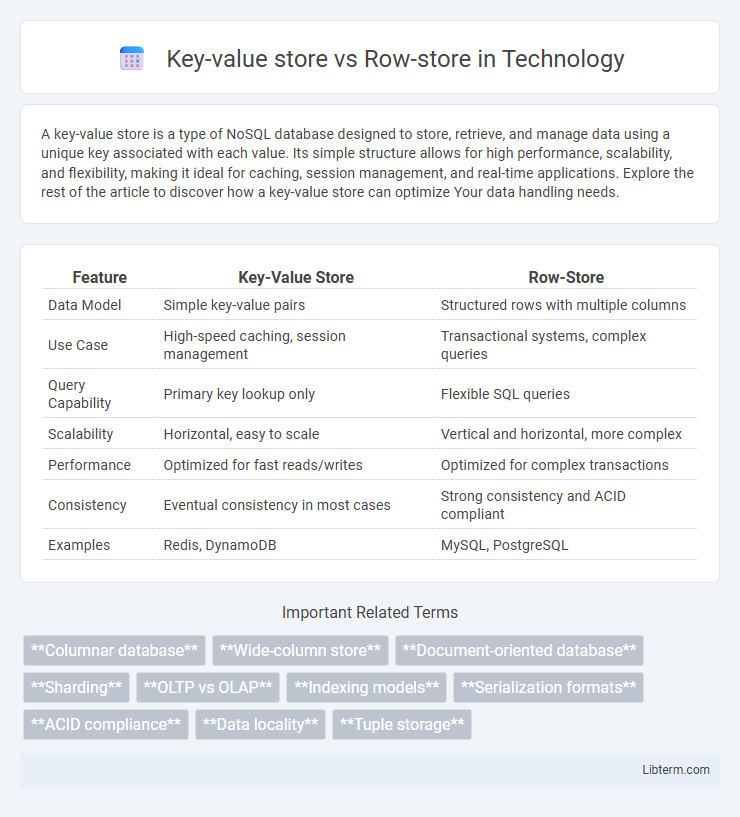A key-value store is a type of NoSQL database designed to store, retrieve, and manage data using a unique key associated with each value. Its simple structure allows for high performance, scalability, and flexibility, making it ideal for caching, session management, and real-time applications. Explore the rest of the article to discover how a key-value store can optimize Your data handling needs.
Table of Comparison
| Feature | Key-Value Store | Row-Store |
|---|---|---|
| Data Model | Simple key-value pairs | Structured rows with multiple columns |
| Use Case | High-speed caching, session management | Transactional systems, complex queries |
| Query Capability | Primary key lookup only | Flexible SQL queries |
| Scalability | Horizontal, easy to scale | Vertical and horizontal, more complex |
| Performance | Optimized for fast reads/writes | Optimized for complex transactions |
| Consistency | Eventual consistency in most cases | Strong consistency and ACID compliant |
| Examples | Redis, DynamoDB | MySQL, PostgreSQL |
Introduction to Data Storage Models
Key-value stores organize data as a collection of key-value pairs, providing efficient retrieval for simple queries by using unique keys, ideal for caching and session management. Row-stores structure data in rows, storing all attributes of an entity together, which optimizes transactional operations and queries accessing entire records. Understanding these data storage models is essential for selecting the right system based on performance needs and query complexity in database design.
What is a Key-Value Store?
A key-value store is a type of NoSQL database designed for storing, retrieving, and managing associative arrays where keys serve as unique identifiers for their corresponding values. Unlike row-store databases that organize data into tables with rows and columns, key-value stores enable ultra-fast lookups and simple data structures ideal for caching, session management, and real-time applications. Popular examples include Redis, Amazon DynamoDB, and Riak, which prioritize scalability and performance over complex query capabilities.
Understanding Row-Store Architecture
Row-store architecture organizes data by storing complete rows together in contiguous memory or disk blocks, optimizing for queries that access multiple columns within the same row. This structure enhances performance for transactional workloads by enabling quick retrieval and updates of entire records. In contrast to key-value stores, which focus on fast access to values via unique keys, row-stores maintain relational data integrity and support complex multi-attribute queries efficiently.
Performance Differences: Key-Value vs Row-Store
Key-value stores excel in performance for simple lookup and write operations due to their schema-less design and direct access to values via unique keys, resulting in low latency and high throughput. Row-stores, optimized for transactional workloads, perform efficiently in complex queries involving multiple columns and support multi-attribute indexing but incur overhead from schema parsing and row locking mechanisms. Performance differences become pronounced in scenarios with high write volume and simple access patterns favoring key-value stores, whereas row-stores maintain better efficiency for relational queries and complex transactional consistency.
Scalability and Flexibility in Both Models
Key-value stores excel in scalability by distributing data across multiple nodes using consistent hashing, enabling seamless horizontal scaling and high availability in distributed systems. Their schema-less design provides flexibility for handling diverse and evolving data types without complex migrations. Row-stores, while offering strong ACID compliance and optimized query performance for relational data through structured schemas, face challenges scaling horizontally but support flexible indexing and complex transactions within vertical scaling limits.
Use Cases for Key-Value Stores
Key-value stores excel in scenarios requiring high-speed read and write operations, such as caching, session management, and real-time data analytics. Their simple data model supports rapid retrieval of values by keys, making them ideal for handling large-scale distributed systems and IoT applications. Use cases include user profile storage, shopping cart data, and real-time leaderboard tracking where low latency and horizontal scalability are critical.
Use Cases for Row-Stores
Row-stores excel in transactional workloads where quick, atomic reads and writes on entire records are critical, such as in Online Transaction Processing (OLTP) systems and customer relationship management (CRM) applications. Their structure supports efficient execution of queries involving multiple columns within the same row, making them ideal for scenarios requiring frequent updates and complex row-based operations. Use cases include inventory management, financial transactions, and real-time analytics in applications demanding strong consistency and low-latency access to full records.
Data Consistency and Integrity Concerns
Key-value stores prioritize high availability and scalability, often sacrificing strong data consistency and integrity guarantees through eventual consistency models, making them suitable for use cases tolerating temporary data staleness. Row-stores, or relational databases, enforce strict ACID (Atomicity, Consistency, Isolation, Durability) properties to maintain data integrity and consistency, ensuring reliable transactional support and complex query capabilities. Application scenarios demanding precise data accuracy and compliance typically favor row-store architectures over key-value stores due to their robust consistency mechanisms.
Choosing the Right Storage Model for Your Needs
Key-value stores offer superior performance for simple lookup operations by storing data as key-value pairs, making them ideal for caching and session management. Row-stores organize data in rows, optimizing complex queries and transaction processing by allowing efficient retrieval of entire records. Selecting the right storage model depends on application requirements: choose key-value stores for high-speed access to individual elements, and row-stores for relational data with complex querying needs.
Future Trends in Data Storage Technologies
Future trends in data storage technologies highlight key-value stores' growing dominance due to their scalability and low-latency access for large-scale applications like IoT and real-time analytics. Row-store databases continue evolving with enhanced support for hybrid transactional and analytical processing (HTAP), leveraging in-memory capabilities and AI-driven optimization to handle complex queries efficiently. Advances in distributed architectures and persistent memory technology are expected to bridge performance gaps between key-value and row-store systems, fostering more versatile and adaptive storage solutions.
Key-value store Infographic

 libterm.com
libterm.com